Review of the best potato varieties: the tastiest and most productive
As in the good old days, potatoes continue to be very popular among the population. However, its outstanding taste is always a separate story. It has long been noticed that culinary delights with potatoes begin to "play" in a new way, more interesting. It is noteworthy that no one has to be persuaded to taste the dish, and it is usually consumed in incredible quantities.
However, in order for the potatoes to be a success, it is necessary to attend to the selection of varieties that do not create problems in growing and meet all the needs of gourmets. And of course, do not forget about such an important characteristic of a potato variety as its yield.
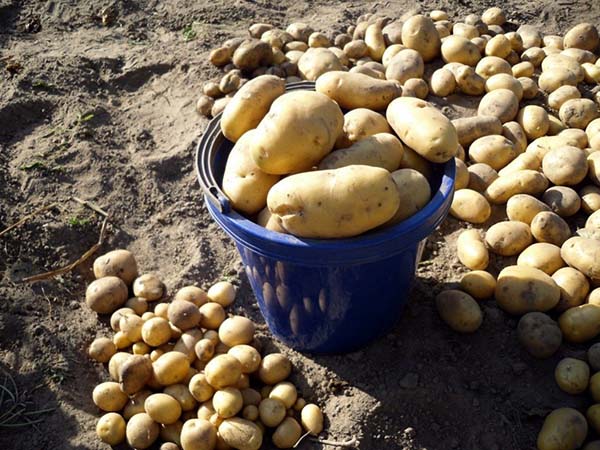
Content
The best potato varieties: top 36 in yield and taste
Remember! You can get a rich harvest of delicious potatoes only if you follow 3 main points:
1. Purchased high-quality planting material suitable for the region and climate.
2. You have fertile land, you follow the rules of crop rotation.
3. You are using the correct potato farming technique.If you do not observe at least one of the points, then there can be no talk of any high yields and tasty tubers.
Next, we will consider in detail the most popular potato varieties (in alphabetical order), which are popularly recognized due to their high yield, or due to excellent taste, although most often they combine both main characteristics.
Aurora
Mid-season variety, for table use, high-yielding, excellent taste.
The variety is able to adapt to any climatic growing conditions, and is also not picky about the type of soil.
Resistant to potato crayfish and nematodes, moderately resistant to viruses, moderately susceptible to the causative agent of late blight by tops and tubers,
The taste is excellent. When cooked, the potatoes become crumbly (medium boiling). Culinary type VS. Suitable for making soups and purees.
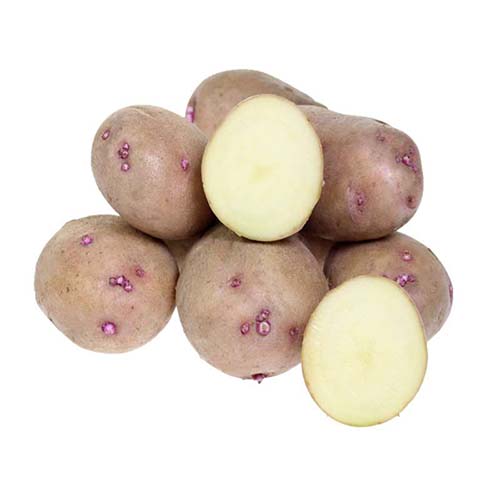
Characteristics of the Aurora variety:
- ripening period - mid-season (90-110 days);
- the shape of the tubers is oval (aligned);
- the structure of the peel is smooth;
- peel color - yellow;
- pulp color - white (cream);
- the depth of the eyes is shallow;
- starch content - 13.5-17.3%;
- yield per hundred square meters - 214-396 kg (maximum up to 416 kg);
- the number of tubers per bush - from 20-25;
- the average weight of 1 tuber is 93-128 g;
- marketability - 80-93%;
- keeping quality - 94%.
In appearance, it is distinguished by tall bushes with large foliage of a light green hue. The inflorescences have a red-purple hue. Berry formation is average.
Recommended for planting regions: North, North-West, Central, Volgo-Vyatka, TsChO, North Caucasian, Middle Volga, East Siberian, Far East.
Patent holder or originator of the variety: Vsevolozhskaya breeding station LLC (Russia).
Adretta
One of the most common old varieties.
Medium early, for table use, high-yielding, excellent taste.
The variety is distinguished by its stable annual yield, very rapid initial development, strong tops and early tuberization.
Gives good results when grown on different types of soil, but it is not suitable for areas that are too dry or often change their moisture content.
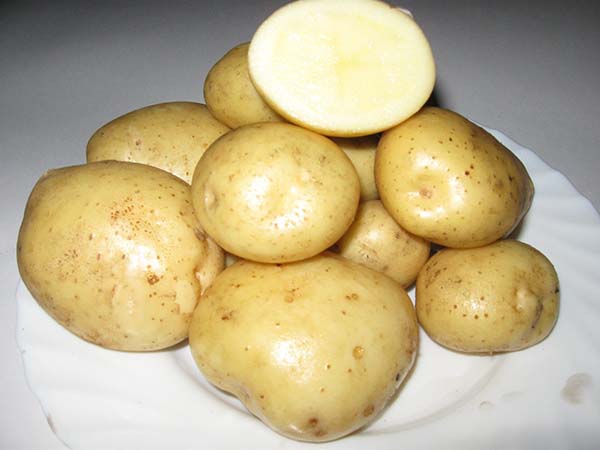
Adretta has increased resistance to common diseases of the culture, and also perfectly tolerates adverse weather conditions (resistant to short-term frosts). Therefore, tubers can be planted already in late April or early May, without fear of return spring frosts.
Important! Increased soil moisture and moisture stagnation negatively affect the tubers. Ripe fruits start to rot in moist soil.
Resistant to cancer, relatively resistant to viruses, but susceptible to late blight, common scab, rhizoctonia.
The taste of the variety is simply excellent, so it can be used in many dishes. Potatoes boil very well during cooking. Culinary type C. Suitable for cooking. For mashed potatoes, it's just the perfect variety, you don't even need to put oil.
Note! Adretta (however, like almost all potato varieties) needs regular renewal of planting material every 3-5 years.
Characteristics of the Adretta variety:
- ripening period - 80-90 days (mid-early), according to other sources - 70-80 days (early);
- tubers - from round-oval to oval;
- the structure of the peel is mesh;
- peel color - yellow;
- pulp color - light yellow;
- the depth of the eyes is shallow;
- starch content - 13-18%;
- yield per hundred square meters - 200-450 kg per one hundred square meters (according to other sources - 214-396 kg);
- the number of tubers in a bush - 15-25 pieces (medium to high).
- the average weight of 1 tuber is 100-150 g;
- marketability - high;
- keeping quality - 98%.
The appearance of the plant is erect, tall, has light green large leaves, the color of the flowers is white.
Recommended for planting regions: Middle Volga, West Siberian and Far Eastern.
Patent holder or originator of the variety: Norika Nordring Kartoffelzucht und Vermehrungs GmbH (Germany).
Bellarosa (Bella Rose or White Rose)
A variety of early ripening, table use, good yield and taste.
Interesting! Due to the specific bright red color of the peel in Russian-speaking countries, it received a popular name - Cherry potatoes.
The variety is not picky about moisture and perfectly tolerates hot periods without loss of fruit quality. Any type of soil is suitable except for heavy loamy soil.
Advice! It is advisable to germinate before planting. Positively responds to fertilization.
In most cases, it manages to bloom by the time a massive amount of the Colorado potato beetle appears. Also, the variety is resistant to the causative agent of potato cancer and nematodes. It tolerates transportation well.
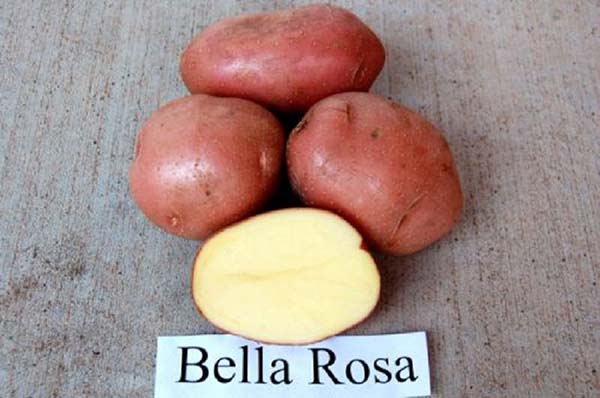
The taste is good. During the cooking process, the pulp becomes crumbly.
Young potatoes can be dug in on the 45th day after germination.
Characteristics of the Bellarosa variety:
- ripening period - early (70-80 days);
- the shape of the tubers is oval-round;
- the structure of the peel is rough;
- peel color - red;
- pulp color - light yellow;
- the depth of the eyes is shallow or medium;
- starch content - 12.6-15.7%
- yield per one hundred square meters - 169-326 kg (maximum up to 385 kg);
- the number of tubers per bush - 8-9;
- the average weight of 1 tuber is 117-207 g;
- marketability - 82-99%;
- keeping quality - 93%.
The appearance of the plant - forms tall erect shoots, with large green leaves. The inflorescences are medium and have a red-purple hue.
Regions recommended for planting: North-West, Volgo-Vyatsky, Central Black Earth Region, Uralsky.
Patent holder and / or originator of the variety: Europlant Pflanzenzucht GmbH (Germany).
Breeze
Medium early variety, for table use, high yield and good taste.
Not picky about the composition of the soil, it can be grown on light and medium-sized soils. Reacts well to mineral fertilizing. Differs in early tuberization and rapid yield accumulation in the first half of the growing season.
Resistant to the causative agent of potato cancer. Resistant to wrinkled, banded mosaics and leaf curling. Moderately susceptible to late blight, rhizoctonia and common scab. Susceptible to nematode. Resistant to mechanical damage.
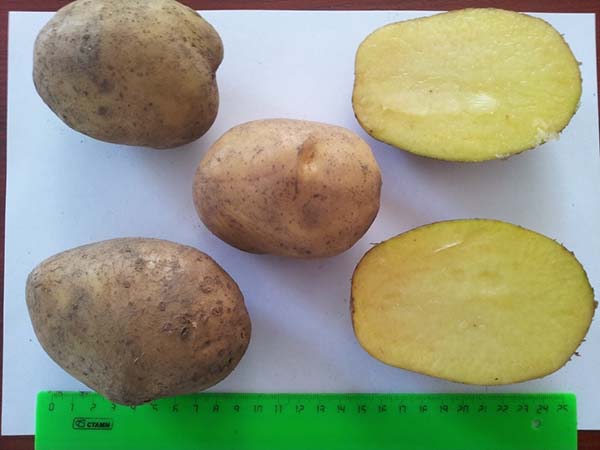
The taste is good. The pulp is poorly boiled during cooking. Culinary type B. Suitable for frozen mixed vegetables and fries.
Characteristics of the Breeze variety:
- ripening period - medium early (80-90 days);
- tubers are oval;
- peel structure - medium smooth;
- peel color - yellow;
- the color of the pulp is yellow;
- the depth of the eyes is shallow or medium;
- starch content - 10.0-15.8%;
- yield per hundred square meters - 160-395 kg (maximum up to 451 kg);
- the number of tubers per bush - 8-12;
- the average weight of 1 tuber is 97-154 g;
- marketability - 83-98%;
- keeping quality - 97%.
The appearance of the plant is of medium height, intermediate type, semi-erect. The leaf is large, intermediate type, green. The waviness of the edge is weak. Inflorescences are medium-sized, reddish-purple.
Recommended planting regions: Northwest, Central.
Patent holder and / or originator of the variety: RUE "Scientific and Production Center of the National Academy of Sciences of Belarus for Potato and Fruit Growing" (Belarus).
Vector
Mid-ripening variety, for table use, good yield and taste.
Not picky about the composition of the soil, but can achieve maximum performance when grown on sod-podzolic and peat-bog soils. It tolerates heat well.
Resistant to the causative agent of potato cancer, susceptible to nematode. Highly resistant to late blight pathogen in tops and tubers, resistant to wrinkled, banded mosaics and leaf curling.The tubers have a dense skin that is resistant to mechanical damage during transportation.
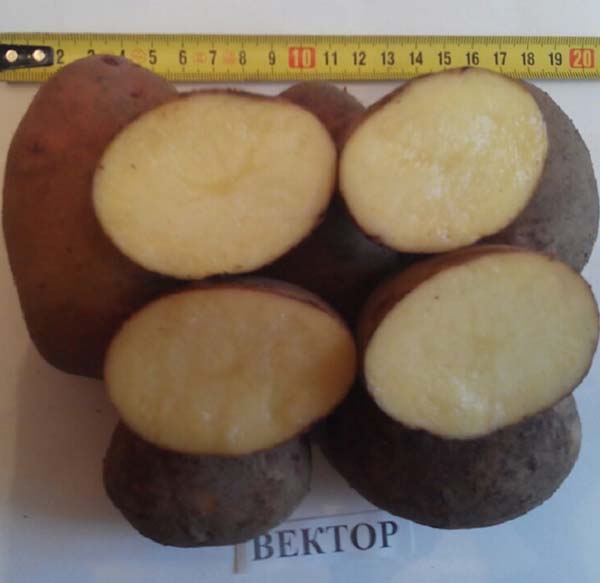
Taste good or great. Culinary type VS. The digestibility is average. The pulp does not darken during cooking. The variety is suitable for the production of starch, chips and purees.
Characteristics of the Vector variety:
- ripening period - mid-season (90-110);
- the shape of the tubers is oval-round;
- the structure of the peel is smooth;
- peel color - red;
- pulp color - light yellow;
- the depth of the eyes is shallow;
- starch content - 16.7-17.5%;
- yield per one hundred square meters - 180-263 kg (maximum up to 403 kg);
- the number of tubers per bush - 10-14;
- the average weight of 1 tuber is 92-143 g.
- marketability - 90-98%;
- keeping quality - 95%.
The appearance of the plant is low, leaf type, semi-erect. The leaf is small, intermediate, dark green. The inflorescences are purple.
Recommended landing regions: Central.
Patent holder and / or originator of the variety: FGBNU “All-Russian Research Institute of Potato Farming named after A.G. Lorkha (Russia).
Vineta (Veneta)
An early variety for table use, medium yield and good taste.
Suitable for growing in regions with harsh climates.
Resistant to the causative agent of potato cancer and nematodes. Susceptible to late blight pathogen in tops, moderately susceptible to tubers. Resistant to wrinkled and banded mosaic viruses, leaf curling, drought tolerant.
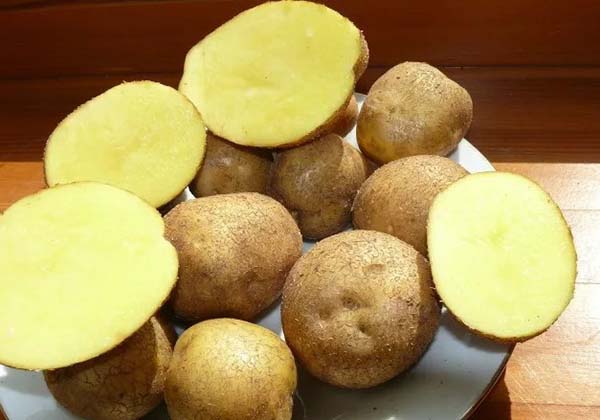
The taste is good and excellent. Culinary type B. In the process of cooking, Veneta does not boil over (boil-through is low), therefore it is recommended for preparing salads.
Note! Excessive application of nitrogen to the soil negatively affects the keeping quality of fruits.
Characteristics of the Vineta (Veneta) variety:
- ripening period - early (70-80 days);
- the shape of the tubers is oval-round;
- the structure of the peel is slightly reticulate;
- peel color - yellow;
- pulp color - light yellow;
- the depth of the eyes is shallow;
- starch content - 12.9-15.2%;
- yield per hundred square meters - 160-228 kg (maximum up to 238 kg);
- the number of tubers per bush - 10-12;
- average weight of 1 tuber - 67-95 g
- marketability - 87-97%;
- keeping quality - 87%.
The appearance of the plant is spreading. The leaf is light green. Low to medium waviness. Corolla small to medium in size, white inflorescences.
Recommended for planting regions: Central, Volgo-Vyatka, TsChO, North Caucasian, Srednevolzhsky, Uralsky.
Patent holder and / or originator of the variety: Europlant Pflanzenzucht GmbH (Germany).
Gala
Medium early variety for table use, good yield and taste.
It perfectly adapts to any climatic conditions and soil composition, but at the same time it is picky about moisture. Therefore, when grown in arid regions, it needs watering, which significantly increases yields. Also responds well to feeding. To improve the keeping quality of fruits, it is recommended to remove all the tops 10 days before harvesting.
Resistant to the causative agent of potato cancer and nematodes. Susceptible to late blight and prone to damage by rhizoctonia. Gala is not susceptible to mechanical damage, and also tolerates transportation well.
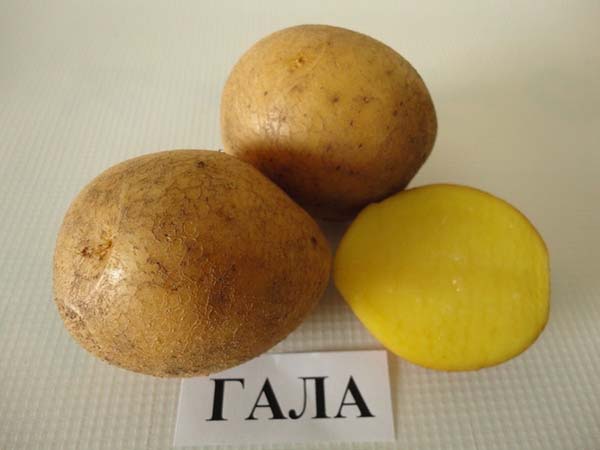
The taste is good. In the process of cooking, it does not boil over and does not change color. Suitable for puree and boiling.
Note! Potatoes are suitable for dietary nutrition, because tubers are low in starch and high in carotene.
Characteristics of the Gala variety:
- ripening period - medium early (80-90 days);
- the shape of the tubers is elongated-oval;
- skin texture - smooth to medium;
- peel color - yellow;
- the color of the pulp is dark yellow;
- the depth of the eyes is shallow;
- starch content - 10.2-13.2%.
- yield per hundred square meters - 216-263 kg (maximum 390 kg);
- the number of tubers per bush - up to 25;
- the average weight of 1 tuber is 71-122 g;
- marketability - 71-94%
- keeping quality - 89%.
The appearance of the plant is of medium height, intermediate type, semi-erect. The leaf is large, intermediate, green. Low to medium waviness. Inflorescences are white.
Recommended for planting regions: North-West, Central, Volgo-Vyatka.
Patent holder and / or originator of the variety: Norika Nordring Kartoffelzucht und Vermehrungs GmbH (Germany).
Blue
Mid-season growth, table purpose, high yield and excellent taste.
Interesting! It blooms with white-blue or blue-violet flowers, which gave the name to the variety.
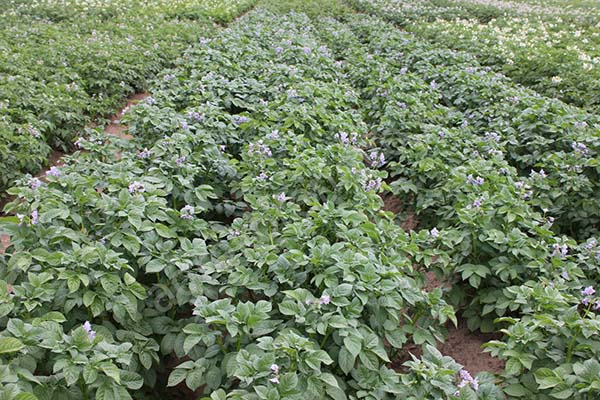
It adapts to almost any conditions. Drought-resistant, but loves moisture, tolerates low temperatures well.
Note! When planting, the seed can be cut, and also make the minimum aisles (plant as densely as possible).
Resistant to cancer, moderately resistant to rhizoctonia, common scab, and potato viruses. Moderately susceptible to late blight in tops and tubers. Susceptible to nematode.
The taste is excellent. Culinary type VS. In the process of cooking, the pulp does not darken, when ready it crumbles (average boiling rate). The variety is recommended for making mashed potatoes and first courses (soups). Suitable for the production of starch and potato crisps (chips).
Characteristics of the Golubizna variety:
- ripening period - mid-season (90-110 days), according to other sources, medium-late (110-120 days);
- the shape of the tubers is oval-round;
- the structure of the peel is mesh;
- peel color - light beige (cream);
- pulp color - cream;
- the depth of the eyes is shallow;
- starch content - 17-19%;
- yield per hundred square meters - 400-500 kg;
- the number of tubers per bush - 10-12;
- the average weight of 1 tuber is 90-110 g;
- marketability - 91-95%;
- keeping quality is high.
The appearance of the bushes is of medium height, multi-stemmed, semi-erect. Medium to large leaf, dark green, glossy. Inflorescences are medium. No berry formation.
Recommended for planting regions: Central, Volgo-Vyatka, TsChO, North Caucasian.
Patent holder and / or originator of the variety: FGBNU “All-Russian Research Institute of Potato Farming named after A.G. Lorkha (Russia).
Zhukovsky early
An early variety for table use, high yield and medium flavor.
It perfectly adapts to changing climatic conditions, is relatively heat and drought resistant. The yield is stable.
Important! Zhukovsky grows amicably even in poorly warmed soil, so the variety can be safely planted at the end of April.
Resistant to potato crayfish and nematodes. Susceptible to tops and tubers to the causative agent of late blight. The tubers are resistant to mechanical damage.
The taste is satisfactory and good. Culinary type B. Boiled weak. During the cooking process, the pulp darkens slightly. Great for frying, making French fries, and making chips. Can be used for puree and cooking, but not very suitable.
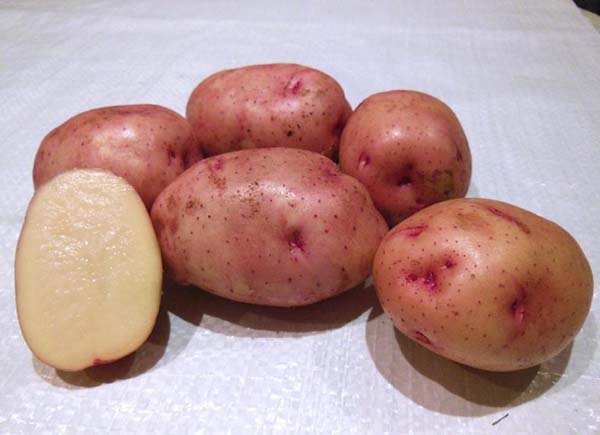
Characteristics of the early Zhukovsky variety:
- ripening period - early (70-80 days), according to other sources, very early (60-80 days);
- the tubers are oval-round;
- the structure of the peel is smooth;
- peel color - pink;
- the color of the pulp is white;
- the depth of the eyes is shallow;
- starch content - 10-12%;
- yield per one hundred square meters - 400-450 kg;
- the number of tubers per bush - 9-15;
- the average weight of 1 tuber is 100-120 g;
- marketability - 90-92%;
- keeping quality is good.
Appearance - bushes of medium height, semi-spreading stem type, the leaf is small, green (glossy), the flowers have a red-violet hue. Berry formation is rare.
Recommended for planting regions: North-West, Central, Volgo-Vyatka, Central black earth, North Caucasian, Middle Volga, Nizhnevolzhsky, Ural, West Siberian, Far East.
Patent holder and / or originator of the variety: FGBNU “All-Russian Research Institute of Potato Farming named after A.G. Lorkha (Russia).
Zhuravinka
Medium late variety, for table use, medium yield and good taste.
Suitable for growing on light to medium-sized soils. Does not tolerate waterlogging of the soil or moisture deficit during the growing season. It reacts negatively to excessive application of nitrogen to the soil, but is very responsive to the application of organic and mineral fertilizers.
Resistant to the causative agent of potato cancer, nematode and common scab. Moderately susceptible to late blight and rhizoctonia. Moderately resistant to mechanical damage.
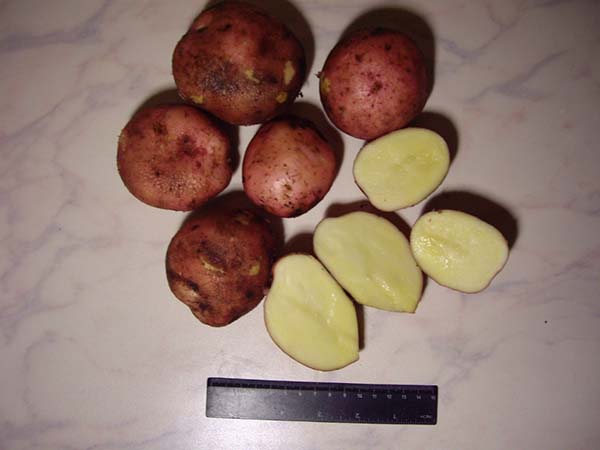
The taste is good. Culinary type VS. The pulp is moderately soft. Does not darken during cooking. The variety is recommended for cooking chips, french fries, starch.
Characteristics of the Zhuravinka variety:
- ripening period - medium late (110-120 days);
- the shape of the tubers is oval-round;
- the structure of the peel is slightly rough (rather smooth);
- peel color - red;
- pulp color - light yellow;
- the depth of the eyes is shallow;
- starch content - 14.6-19.6%;
- yield per one hundred square meters - 177-242 kg.
- the number of tubers per bush - up to 18;
- the average weight of 1 tuber is 89-139 g;
- marketability - 83-96%;
- keeping quality - 93%.
The appearance of the plant is of medium height, intermediate type, semi-erect. The leaf is small, intermediate, dark green. The waviness of the edge is weak. Inflorescences are medium-sized, reddish-purple. The berries are practically not formed (rarely).
Recommended for planting regions: North-West, Central, Volgo-Vyatka.
Patent holder and / or originator of the variety: RUE "Scientific and Production Center of the National Academy of Sciences of Belarus for Potato and Fruit Growing" (Belarus).
Zekura
Medium early variety, for table use, good yield and taste.
It gained its popularity due to its undemanding care and stability of the crop, even in the conditions of the short Siberian summer.
It responds well to watering and loosening wet soil; during the period of tops formation, it is important to remove weeds in a timely manner. Drought-resistant, but at the same time suitable for soils with high humidity.
Resistant to cancer and potato nematode. It is not very susceptible to the leaf-rolling virus, weakly affected by the virus "U" and "A", late blight of leaves and tubers, scab and glandular spot.
Taste good or great. Suitable for the production of potato products (chips, fries). Cooking is medium, suitable for both mashed potatoes and soups.
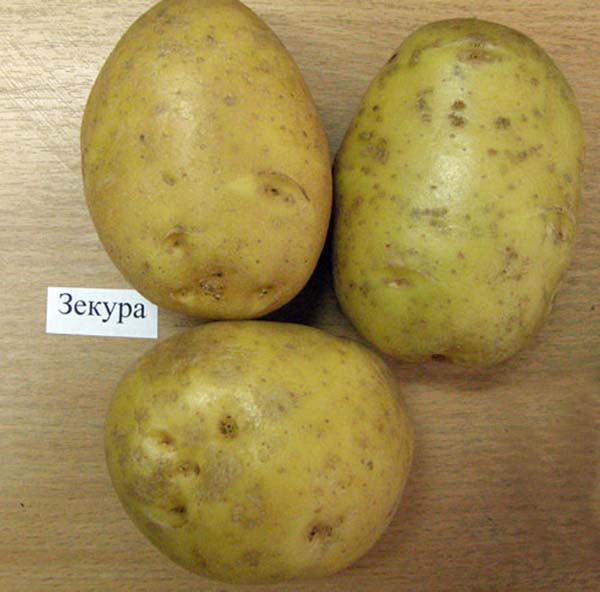
Characteristics of the Zekura variety:
- ripening period - medium early (80-90 days);
- tubers shape - oblong;
- the structure of the peel is smooth;
- peel color - yellow;
- the color of the pulp is yellow;
- the depth of the eyes is shallow;
- starch content - 13.0-18.2%;
- yield per hundred square meters - 195-323 kg (maximum up to 365 kg);
- the number of tubers per bush - 17-20;
- the average weight of 1 tuber is 59-150 g;
- marketability - 79-96%;
- keeping quality is good.
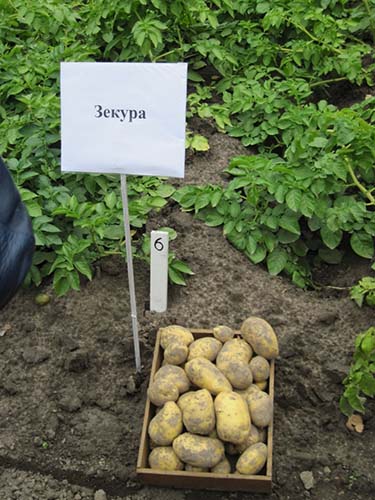
The appearance of the bush is of medium height, semi-erect, intermediate type. Inflorescences are red-purple. The base of the sprout is red-violet.
Recommended for planting regions: Volgo-Vyatka, TsChO, North Caucasian, Middle Volga, West Siberian, Far Eastern.
Patent holder and / or originator of the variety: Solana GmbH & Co.KG (Germany).
Impala
An early variety, for table use, good yield and taste.
Differs in crop stability under all weather conditions, including high temperature resistance. The main thing is not to overdo it with nitrogen fertilizers.
In the southern regions, it is possible to get two crops at once in 1 season.
Note! When planting, the seed is recommended to germinate. Also, you can not break off the sprouts and do not plant in unheated soil.
It is resistant to cancer and potato nematode, susceptible to late blight and rhizoctonia disease, weakly affected by viral diseases and common scab.
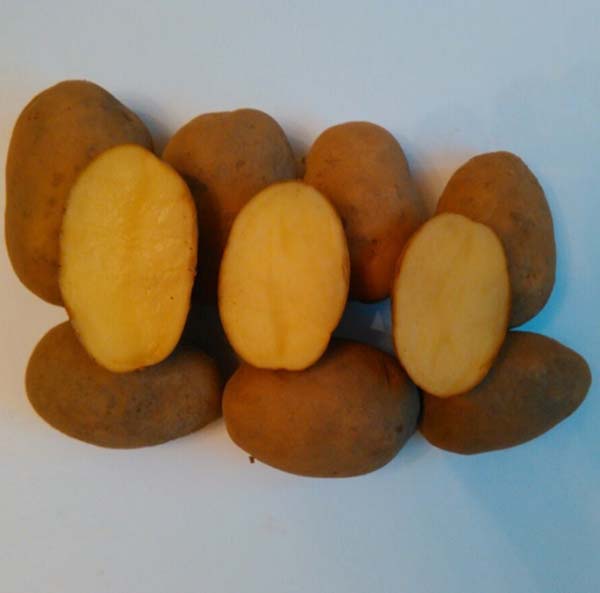
The taste is good. During the cooking process, the pulp does not darken or crumble. Ideal for frying and cooking French fries.
Characteristics of the Impala variety:
- ripening period - early (70-80 days);
- tubers are oval;
- peel color - yellow;
- pulp color - light yellow;
- the depth of the eyes is shallow;
- starch content - 10.5-14.6%;
- yield per hundred square meters - 180-360 kg (maximum - 367 kg);
- the number of tubers per bush - 16-21;
- the average weight of 1 tuber is 88-150 g;
- marketability - 89-94%;
- keeping quality - 90%.

The appearance of the plant is tall, erect. Flowers are white.
Recommended for planting regions: North-West, Central, Volgo-Vyatka, Nizhnevolzhsky.
Patent holder and / or originator of the variety: Agrico U.A. (Holland).
Kamensky
The variety is early maturing, for table use, medium yield and good taste.
It is characterized by early harvest accumulation and leveled tubers with high marketability.
It adapts well to all types of soil. Differs in drought resistance due to the early formation of tubers. Requires loosening of the soil, responds positively to fertilization and watering. The tough leaves of adult plants do not like the Colorado potato beetle.
Resistant to the causative agent of potato cancer. Susceptible to nematode. Medium resistant to late blight pathogen, resistant to wrinkled and banded mosaics, leaf twisting, common scab and rhizoctonia.
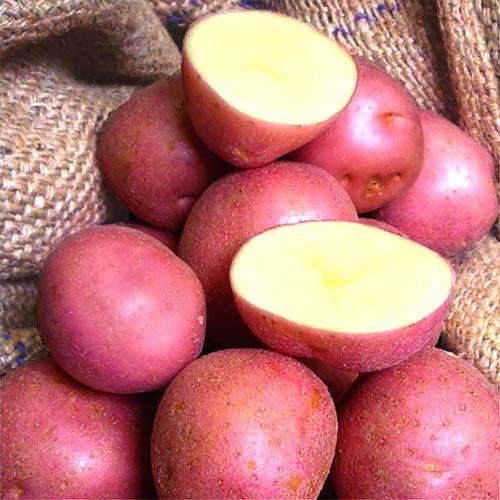
The taste is good. Culinary type B (poor digestibility).
Characteristics of the Kamensky variety:
- ripening period - early (70-80 days);
- the shape of the tubers is elongated-oval;
- the structure of the peel is smooth;
- peel color - red;
- pulp color - light yellow;
- the depth of the eyes is shallow;
- starch content - 12.2-16.8%;
- yield per hundred square meters - 185 kg (maximum up to 252 kg);
- the number of tubers per bush - 15-25;
- the average weight of 1 tuber is 96-108 g;
- marketability - 85-94%;
- keeping quality - 97%.
The appearance of the plant is of an intermediate type, semi-erect. Medium leaf, intermediate type, dark green. Strong edge waviness. The intensity of the anthocyanin coloration of the inner side of the corolla is from medium to strong, the proportion of blue is absent or very small. The inflorescences are large. and red and purple. Berry formation is rare.
Recommended for planting regions: Volgo-Vyatka, Ural, West Siberian.
Patentee and / or originator of the variety: FGBNU "Ural Research Institute of Agriculture" (Russia).
Kiwi
Late-ripening variety, table purpose, high yield and mediocre (normal) taste.
Note! Planting material is very difficult to find due to its rarity. But as they say, he who seeks will always find.
Perfectly adapts to any climatic conditions. Kiwi can grow in any type of soil.
Practically not damaged by wireworm and Colorado potato beetle (as it contains bio-fiber). It is also not affected by late blight, common scab, late blight, potato cancer.
Interesting! The elongated tubers have a rough mesh surface, reminiscent of a kiwi peel, which gave the species its name.
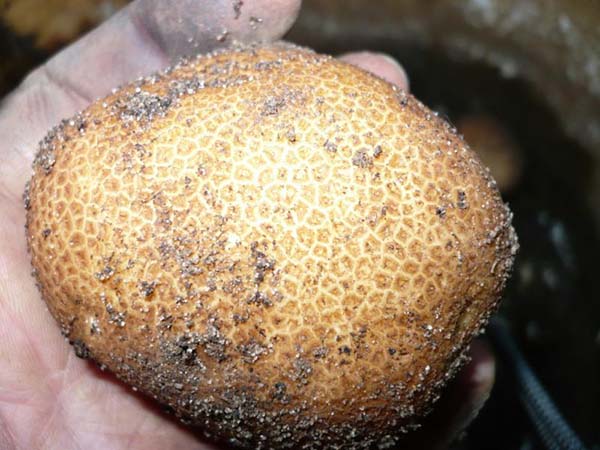
Taste is satisfactory or mediocre (practically tasteless). When cooking, the friability is average. Suitable for puree. Almost unsuitable for frying, as it burns due to the high dry matter content.
Characteristics of the Kiwi variety:
- ripening period - late ripening (120-140 days);
- the shape of the tubers is round;
- peel structure - rough (mesh);
- peel color - orange-brown;
- the color of the pulp is white;
- the depth of the eyes is shallow;
- starch content - unknown;
- yield per hundred square meters - high (up to 400 kg);
- the number of tubers per bush is unknown;
- the average weight of 1 tuber is unknown;
- marketability - unknown;
- keeping quality is good.
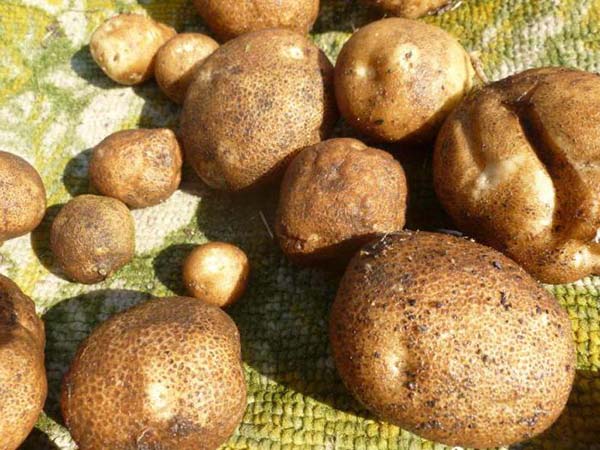
Differs in tall bushes, with a large number of densely leafy shoots. The inflorescences have a deep lilac hue, but rarely blooms.
Recommended for planting regions (presumably): Central.
Patentee and / or originator of the variety: unknown (according to some sources, the variety is GMO, but this is inaccurate).
Gingerbread man
Mid-season variety, for table use, average yield, with good culinary qualities.
It is relatively resistant to heat and drought.
Resistant to the causative agent of potato cancer, susceptible to nematode. Moderately susceptible to tops and susceptible to tubers to the causative agent of late blight, common scab.
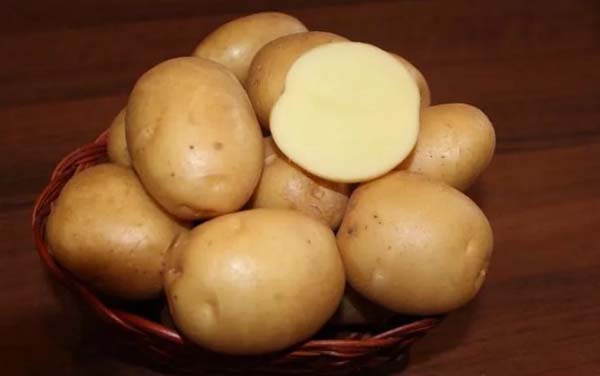
Taste good or great. Culinary type C. Cooking is good, the pulp does not darken. Suitable for processing into crispy potatoes (fries and chips).
Characteristics of the Kolobok variety:
- ripening period - mid-season (90-110 days);
- the shape of the tubers is round;
- the structure of the peel is slightly rough;
- peel color - yellow;
- the color of the pulp is yellow;
- the depth of the eyes is from medium to deep;
- starch content - 11.4-13.0%, according to other sources - 16-18.5%;
- yield per hundred square meters - 124-227 kg (maximum up to 256 kg);
- the number of tubers per bush - 11-17;
- the average weight of 1 tuber is 93-118 g;
- marketability - 87-97%;
- keeping quality - 98%.
The appearance of the bushes is a medium to tall plant, intermediate type, semi-erect. Medium to large leaf, intermediate, light green. The waviness of the edge is weak. Inflorescences are very large and white. Berry formation is rare.
Recommended landing regions: Central.
Patent holder and / or originator of the variety: FGBNU “All-Russian Research Institute of Potato Farming named after A.G. Lorkha (Russia).
Colomba (Colombo)
Very early variety, for table use, high yield and good taste.
Gives good performance when grown on loams and chernozem with low acidity.
The variety must be planted only in well-warmed soil, so there is no need to rush to planting. And also needs additional introduction of magnesium and manganese into the soil. It responds well to watering.
Resistant to the causative agent of potato cancer, nematode. Moderately susceptible to late blight pathogen.
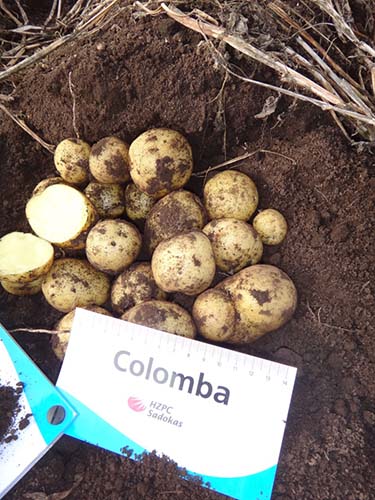
Taste good or great. When boiling or roasting, the tubers do not fall apart and retain their shape. Suitable for any type of heat treatment.
Characteristics of the Colomba variety:
- ripening period - very early (60-70 days);
- the shape of the tubers is oval-round;
- the structure of the peel is smooth;
- peel color - yellow;
- the color of the pulp is yellow;
- the depth of the eyes is shallow to medium;
- starch content - 11.0-15.0%;
- yield per one hundred square meters - 224-422 kg;
- the number of tubers per bush - up to 12;
- the average weight of 1 tuber is 82-126 g;
- marketability - 81-98%;
- keeping quality - 95%.
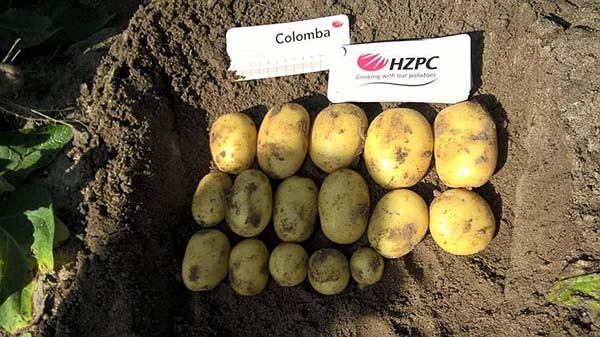
The appearance of the bushes is a plant of medium height, leaf type, from semi-erect to spreading. Medium to large green leaf. The intensity of anthocyanin coloration on the inner side of the corolla is absent or very weak. Inflorescences are red-violet.
Regions recommended for planting: North-West, Central, Volgo-Vyatka, Central Black Earth Region, North Caucasian.
Patent holder and / or originator of the variety: HZPC Holland B.V. (Holland).
Queen Anne
An early variety for table use, high yield, excellent taste.
Interesting! This particular variety is grown by the President of the Republic of Belarus Alexander Grigorievich Lukashenko in his residence "Drozdy".
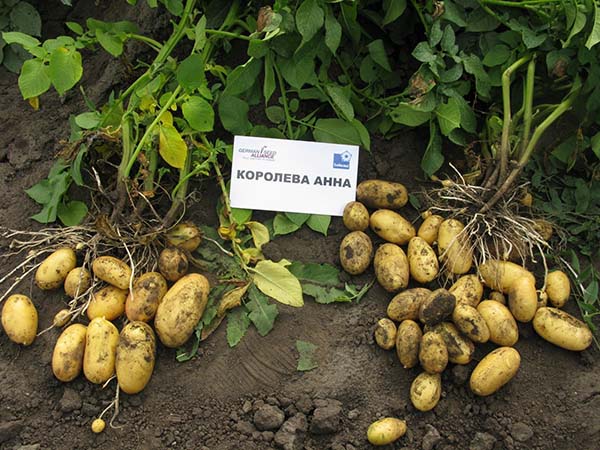
Pre-germination and planting in warm soil is desirable.
Note! When grown in arid regions, it needs abundant watering.
Resistant to the causative agent of potato cancer, golden potato cyst nematode. Resistant to wrinkled striped mosaics and leaf curling. Transport transfers without loss of marketability.
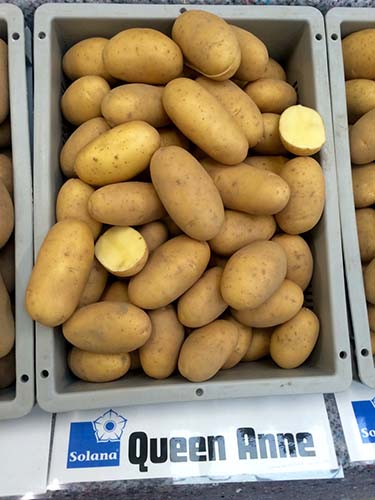
The variety has an excellent taste. Does not darken, does not boil over (weak). Recommended for frying, making soups, salads.
Characteristics of the Koroleva Anna variety:
- ripening period - early (70-80 days);
- the shape of the tubers is elongated-oval;
- the structure of the peel is smooth;
- peel color - yellow;
- the color of the pulp is yellow;
- the depth of the eyes is very shallow or shallow;
- starch content - 13.1-14.4%;
- yield per hundred square meters - 113-304 kg (maximum up to 495 kg);
- the number of tubers per bush - 6-16;
- the average weight of 1 tuber is 84-137 g;
- marketability - 82-96%;
- keeping quality - 93%.
The appearance of the plant is of medium height, stem type, has semi-spreading shoots. Leaves are medium or large, closed, green. Inflorescences are white.
Regions recommended for planting: North-West, Central, Volgo-Vyatka, Central Black Earth Region, North Caucasian, Middle Volga, West Siberian, East Siberian.
Patent holder and / or originator of the variety: Solana GmbH & Co. KG (Germany).
Labella
An early variety, for table use, medium yield, excellent taste.
Resistant to high temperatures during the growing season, has excellent adaptability to climatic conditions and soil types.
Resistant to the causative agent of potato cancer and nematodes. Highly resistant to leaf roll virus.
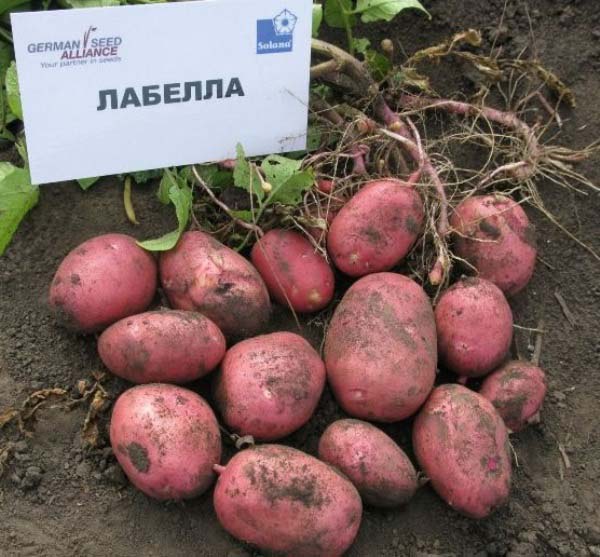
The taste is excellent. The digestibility is average.
Characteristics of the Labella variety:
- ripening period - early (70-80 days);
- the shape of the tubers is elongated-oval;
- the structure of the peel is smooth;
- peel color - red;
- the color of the pulp is yellow;
- the depth of the eyes is shallow to medium;
- starch content - 15.8%;
- yield per hundred square meters - 176-264 kg (maximum up to 342 kg);
- the number of tubers per bush - up to 14;
- the average weight of 1 tuber is 78-102 g;
- marketability - 91-92%;
- keeping quality - 98%.
The appearance of the plant is from medium height to high, leaf type, semi-erect. The leaf is large, intermediate, green. Inflorescences are red-purple.
Recommended for planting regions: Central, North Caucasian, Middle Volga, Ural.
Patent holder and / or originator of the variety: Den Hartigh BV (Holland).
Lasunak (Lasunok)
Late-ripening variety, versatile, high yield and good taste.
Suitable for growing on all types of soil. It makes good use of natural fertility and has a high return on fertilization. Differs in the rapid accumulation of yield in the initial growing season.
To avoid the strong development of tops, it is necessary to apply nitrogen fertilizers 10-15% less than the recommended doses.
Resistant to cancer, viruses "S", "M", "Y", "L", moderately resistant to late blight (tuber), moderately susceptible to late blight of leaves, common scab, rhizoctonia, black leg, susceptible to virus "X" and nematode. Resistant to mechanical damage.
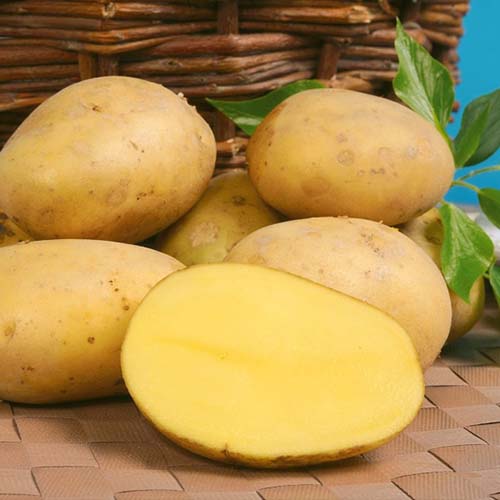
Taste good or great. Good digestibility (culinary type C). Suitable for the production of crisp potatoes (chips), dry mashed potatoes, starch, frozen potato pancakes, frozen vegetable mixtures, side dishes and fries.
Characteristics of the Lasunak variety:
- ripening period - late ripening (120-140 days), according to other sources - medium late (110-120 days);
- the shape of the tubers is round-oval;
- the structure of the peel is mesh;
- peel color - light yellow;
- pulp color - cream;
- the depth of the eyes is average;
- starch content - 15-22%;
- yield per hundred square meters - 400-450 kg (maximum up to 630 kg);
- the number of tubers per bush - 8-12;
- the average weight of 1 tuber is 150-200 g;
- marketability is good;
- keeping quality is satisfactory and good.
The appearance of the bushes is a tall, erect plant. Leaves are medium, green. Inflorescences are large, white in color. Berry formation is rare.
It has a short dormant period of tubers, therefore, strict adherence to the storage regime (1-2 degrees) is required.
Regions recommended for planting: North-West, Central, Volgo-Vyatka, Central Black Earth Region, North Caucasian.
Patent holder and / or originator of the variety: RUE "Scientific and Production Center of the National Academy of Sciences of Belarus for Potato and Fruit Growing" (Belarus).
Lugovskoy
Mid-season growth, table purpose, high yield, good taste.
It is characterized by a stable yield. Can be grown in almost any climatic conditions.
In the process of cultivation, it responds well to hilling and deep loosening of the soil.
Resistant to cancer, relatively resistant to late blight, common scab, moderately resistant to viruses, blackleg.
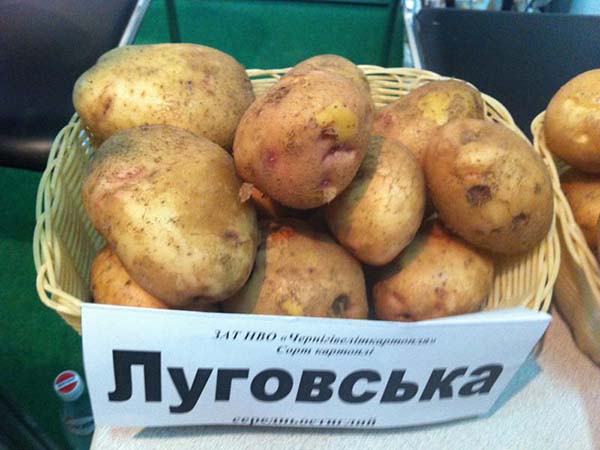
The taste is good, without excessive dryness and wateriness. The pulp does not darken. Lugovsky is recommended for making mashed potatoes and getting starch.
Characteristics of the Lugovskoy variety:
- ripening period - mid-season (90-110 days);
- tubers are oval;
- the structure of the peel is mesh;
- peel color - light pink;
- the color of the pulp is white;
- the depth of the eyes is shallow;
- starch content - 12-19%;
- yield per hundred square meters - high (maximum up to 514 kg);
- the number of tubers per bush - 10-15;
- the average weight of 1 tuber is 85-125 g;
- marketability - high;
- keeping quality is good.
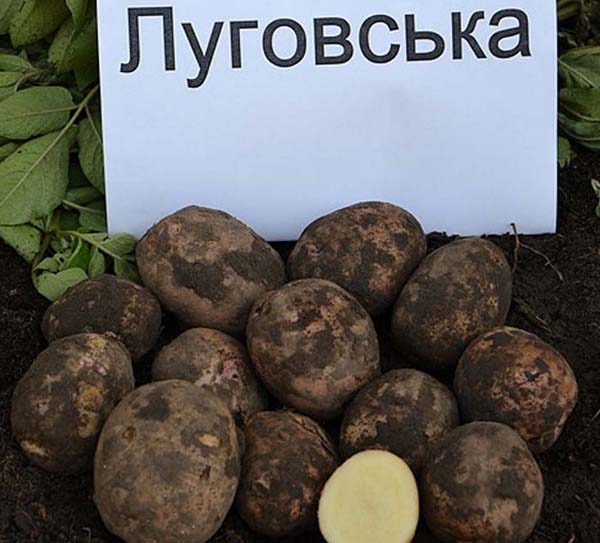
The appearance of the plant is erect, of medium height, the color of the flowers is white.
Recommended for planting regions: North, North-West, Central, Volgo-Vyatka, Central Black Earth Region, North Caucasian, Nizhnevolzhsky, Ural, West Siberian, East Siberian, Far East.
Patent holder and / or originator of the variety: Institute of Potato Growing UAAS (Ukraine).
Lyubava
An early variety, for table use, high yield, good taste. Culinary type A (salad type). Does not boil over. The pulp darkens moderately during cooking.
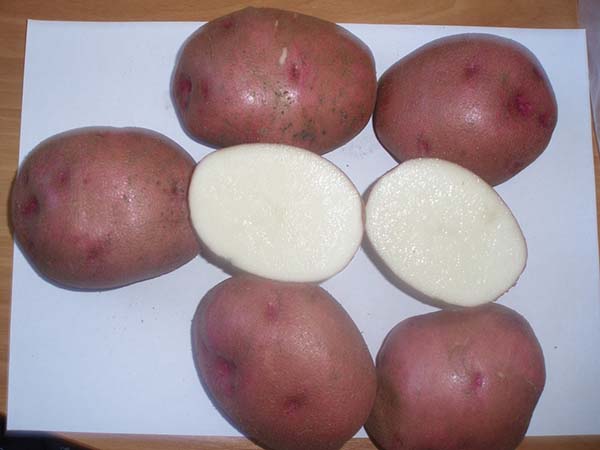
Resistant to the causative agent of potato cancer, rhizoctonia, susceptible to nematode. It is also susceptible in terms of tops and moderately resistant in tubers to the causative agent of late blight. Moderately resistant to common scab.
Characteristics of the Lyubava variety:
- ripening period - early (70-80 days);
- the shape of the tubers is oval-round;
- the structure of the peel is from medium to coarse (according to other sources, it is generally suitable, but flaky at the top);
- peel color - red;
- the color of the pulp is white;
- the depth of the eyes is average;
- starch content - 11.2-16.9%;
- yield per hundred square meters - 288-400 kg (maximum up to 524 kg);
- the number of tubers per bush - 8-15;
- the average weight of 1 tuber is 109-210 g;
- marketability - 80-98%;
- keeping quality is good.
The appearance of the bushes is of medium height, intermediate type, semi-erect. The leaf is small, open, light green. The waviness of the edge is weak. Average gloss. Inflorescences are medium-sized, reddish-purple. Berry formation is rare.
Recommended for planting regions: Ural, West Siberian, East Siberian, Far East.
Patent holder and / or originator of the variety: FGBNU “All-Russian Research Institute of Potato Farming named after A.G. Lorkha (Russia).
Meteor
Very early variety, for table use, high yield, good taste.
Good adaptability to any agro-climatic conditions, heat and drought resistance. It prefers to grow on loamy soil.
Resistant to the causative agent of potato cancer, nematode. Relatively resistant in leaves and highly resistant in tubers to the causative agent of late blight, moderately resistant to wrinkled and banded mosaics, common scab and rhizoctonia. Resistant to mechanical damage.
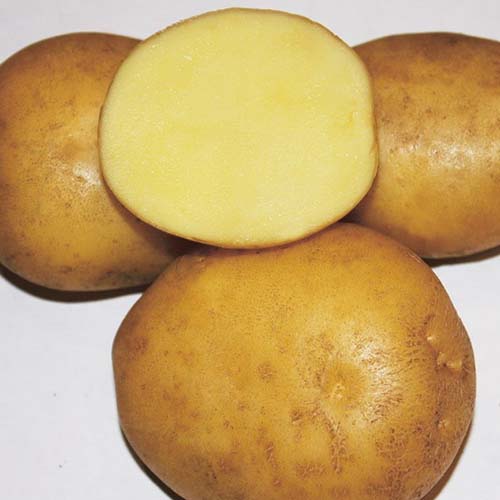
It is characterized by good taste and low digestibility. Culinary type VS. The pulp does not darken during cooking. Suitable for all kinds of dishes. Recommended for frying and baking.
Characteristics of the Meteor variety:
- ripening period - very early (60-70 days);
- the shape of the tubers is oval-round;
- the structure of the peel is smooth;
- peel color - yellow;
- pulp color - light yellow;
- the depth of the eyes is shallow to medium;
- starch content - 12.0-14.9%;
- yield per hundred square meters - 209-404 kg (maximum up to 450 kg);
- the number of tubers per bush - 10-12;
- the average weight of 1 tuber is 102-147 g;
- marketability - 88-98%;
- keeping quality - 95%.
The appearance of the plant is tall, intermediate type, semi-erect. Medium-sized leaf, dark green. The intensity of anthocyanin coloration on the inner side of the corolla is absent or very weak. Inflorescences are small, white. Berry formation is rare.
Recommended for planting regions: Central, Volgo-Vyatka, TsChO, Srednevolzhsky, Uralsky, West Siberian, Far Eastern.
Patent holder and / or originator of the variety: FGBNU “All-Russian Research Institute of Potato Farming named after A.G. Lorkha (Russia).
Nevsky
Medium early variety, for table use, high yield and average (satisfactory) taste.
By the way! According to some sources, the most popular potato variety in Russia.
Suitable for all regions. Nevsky gives good results when grown on sandy loam and loamy soils with a deep arable layer. Resistant to drought and waterlogging.
Important! When planting, it requires preliminary warming up of the seed (you can not plant it directly into cold soil), it is sensitive to the breaking off of sprouts. Responds well to plentiful feeding.To avoid scab damage, requires moist soil at the time of tuber formation.
Resistant to the causative agent of potato cancer, rhizoctonia, potato viruses. Moderately resistant to common scab. Moderately susceptible to late blight in tops and tubers. Resistant to mechanical damage. However, tubers tend to germinate during long-term storage.
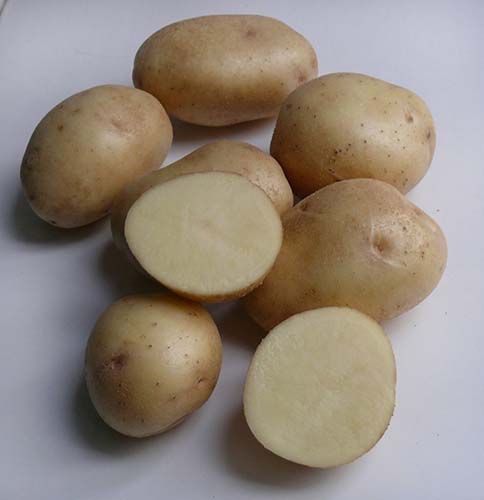
The taste is satisfactory or good. Culinary type VS. The digestibility is poor. The pulp does not darken during the cooking process. Nevsky is suitable for preparing first courses (soups) and second courses (salads), but due to its low starch content, it is not very suitable for mashed potatoes and frying.
Characteristics of the Nevsky variety:
- ripening period - medium early (80-90 days);
- the shape of the tubers is oval, aligned;
- the structure of the peel is smooth or mesh;
- peel color - light beige with pink eyes;
- the color of the pulp is white;
- the depth of the eyes is shallow;
- starch content - 10-12%;
- yield per hundred square meters - 380-500 kg;
- the number of tubers per bush - 17-20;
- the average weight of 1 tuber is 90-130 g;
- marketability - 90-95%;
- keeping quality is good.
The appearance of the plant is semi-erect, intermediate type, of medium height. The leaf is medium, light green, the edge waviness is weak. The flowers are white. Berry formation is average.
Recommended regions for planting: absolutely all regions.
Patent holder and / or originator of the variety: Federal State Budgetary Scientific Institution "Leningrad Scientific Research Institute of Agriculture" Belogorka "(Russia).
Picasso (Limonka)
Late variety, for table use, good yield and satisfactory taste.
Interesting! The variety is named after the artist due to the yellow-pink color of the peel. In Russia, it received a popular name - Limonka potato.
For successful cultivation, preliminary germination of the planting material is recommended, as well as increased fertilization. Picasso is resistant to drought and high temperatures during the growing season.
Resistant to cancer and potato nematode, susceptible to late blight, moderately affected by leaf twisting and common scab. The variety tolerates transportation well
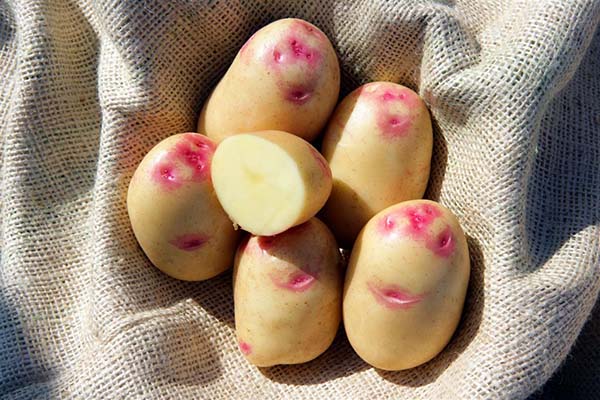
The taste is satisfactory and good. The pulp does not boil during cooking, therefore it is recommended to use it for frying and salads.
Characteristics of the Picasso variety:
- ripening period - late (120-140 days);
- the shape of the tubers is oval-round;
- the structure of the peel is smooth;
- peel color - yellow with pink eyes;
- pulp color - cream;
- the depth of the eyes is shallow;
- starch content - 7.9-13.5%;
- yield per hundred square meters - 193-315 kg (maximum up to 321 kg);
- the number of tubers per bush - up to 19;
- the average weight of 1 tuber is 75-126 g;
- marketability - 79-94.1%;
- keeping quality - 83-90%.
Differs in tall, spreading stems that bloom with snow-white cream flowers. Picasso's leaves are large, dark green. Berry formation is rare.
Recommended for planting regions: Central, TsCHO.
Patent holder and / or originator of the variety: Agrico U.A. (Holland).
Red Scarlet
An early variety, for table use, medium yield, normal (satisfactory) taste.
Prefers to grow in soils with good air permeability. It is optimal to plant tubers with at least 5 or more eyes. Productivity does not fall even with drought and high temperatures during the growing season. All tops should be removed 10 days before harvest. Tubers are formed very amicably (simultaneously).
Resistant to the causative agent of potato cancer, golden potato cyst nematode. Susceptible to late blight pathogen in tops and moderately susceptible to tubers.
Taste properties are within normal limits (taste is satisfactory). During the cooking process, the pulp does not darken, and is also moderately (medium) boiled. Culinary type VS. Suitable for making soups, salads, as well as frying and making chips. Can be used for mashed potatoes and cooking, but not good enough.
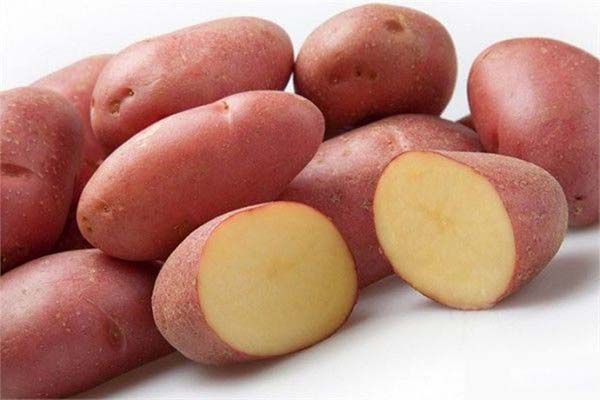
Characteristics of the Red Scarlet variety:
- ripening period - early (70-80 days);
- the shape of the tubers is elongated-oval;
- the structure of the peel is smooth;
- peel color - red;
- the color of the pulp is yellow;
- the depth of the eyes is shallow;
- starch content - 10.1-15.6%;
- yield per hundred square meters - 164-192 kg (maximum 270 kg);
- the number of tubers per bush - up to 15;
- the average weight of 1 tuber is 56-102 g;
- marketability - 82-96%;
- keeping quality - 98%.
The appearance of the plant is low, intermediate type, semi-erect. Leaves are medium-sized, green. Inflorescences are medium-sized, reddish-purple.
Recommended for planting regions: North-West, Central, Volgo-Vyatka, TsChO, West Siberian.
Patent holder or originator of the variety: HZPC Holland B.V. (Holland).
Riviera
An early variety, for table use, high yield, good taste.
Due to early ripening, the plant manages to form fruits before the hot season, therefore, does not need additional watering. In addition, the Riviera forms a powerful root system, which allows it to fully provide shoots and tubers with moisture. It prefers to grow on light soils where it gives a stable annual yield. Differs in drought resistance and resistance to mechanical damage.
Planting should be carried out only in well-heated soil and only with germinated tubers.
Resistant to the causative agent of potato cancer and nematodes. Susceptible to late blight pathogen, resistant to banded mosaic.
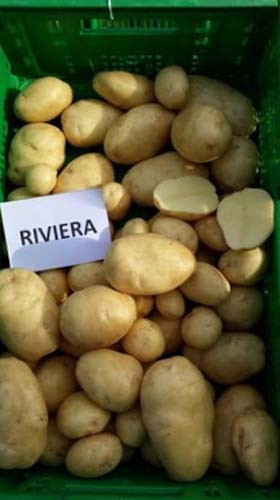
The taste is good. As it cooks, the pulp becomes crumbly.
Characteristics of the Riviera variety:
- ripening period - early (70-80 days);
- tubers are oval;
- the structure of the peel is rough;
- peel color - light beige;
- pulp color - cream;
- the depth of the eyes is shallow to medium;
- starch content - 11.5-15.9%;
- yield per hundred square meters - 189-366 kg (maximum up to 465 kg);
- the number of tubers per bush - 8-12;
- the average weight of 1 tuber is 101-177 g;
- marketability - 80-96%;
- keeping quality - 94%.
Forms strong, but low or medium semi-erect or spreading shoots 70-80 cm high, which practically do not bloom. Medium to large leaf, light green.
Recommended for planting regions: Central, TsChO, North Caucasian.
Patent holder and / or originator of the variety: Agrico U.A. (Holland).
Rodriga (Rodrigo)
Medium early variety, for table use, good yield, excellent taste.
Note! To obtain friendly shoots, seed tubers are recommended to germinate before planting.
It is resistant to the causative agent of potato cancer and golden potato cyst nematode. Also, the variety is not susceptible (resistant) to high temperatures and drought.
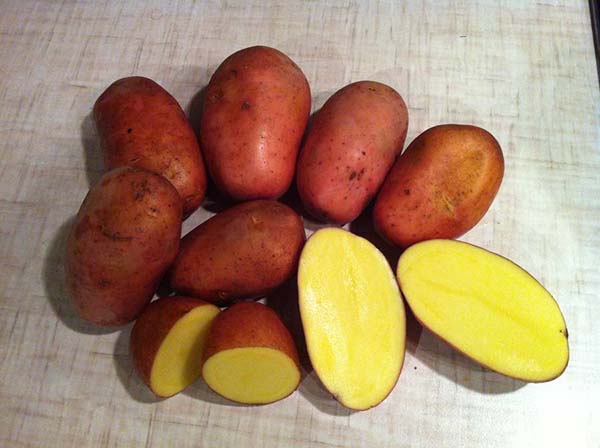
Above average to excellent palatability. Suitable for both frying and mashed potatoes.
Characteristics of the Rodriga variety:
- ripening period - medium early (80-90 days);
- tubers are oval;
- skin structure - smooth to medium;
- peel color - red;
- pulp color - light yellow;
- the depth of the eyes is shallow;
- starch content - 12.5-15.4%;
- yield per hundred square meters - 150-218 kg (maximum up to 382 kg);
- the number of tubers per bush - 7-9;
- the average weight of 1 tuber is 85-147;
- marketability - 85-96%;
- keeping quality - 95%.
The appearance of the bushes is of medium height to high, intermediate type, semi-erect. Medium-sized leaf, intermediate, green to dark green. The waviness of the edge is medium. Inflorescences are medium-sized, reddish-purple.
Recommended for planting regions: Central, Volgo-Vyatka, North Caucasian, Middle Volga, Far East.
Patent holder and / or originator of the variety: Solana GmbH & Co.KG (Germany).
Rosara
An early variety, versatile, high-yielding, good taste.
Regardless of climatic conditions, it is able to give a stable harvest. Not damaged during transportation. It is characterized by amicable ripening of tubers.
When grown, responds well to watering, fertilization.
Resistant to cancer and potato nematode, slightly affected by late blight and common scab.
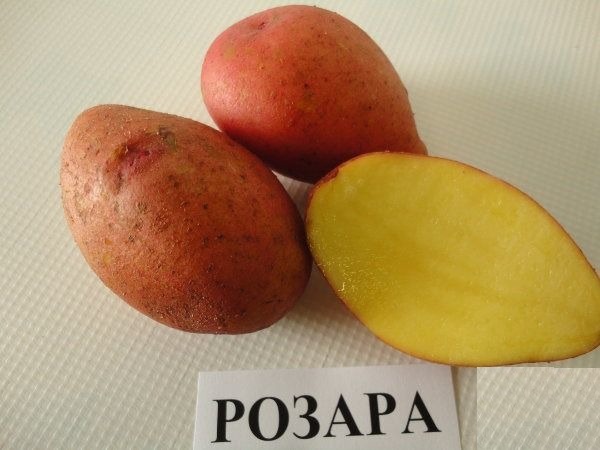
Taste good or great.In the process of cooking, it almost does not boil down, so the variety is ideal for salads, frying, cooking french fries, chips. Not suitable for mashed potatoes and cooking.
Characteristics of the Rosara variety:
- ripening period - early (70-80 days);
- tubers are oblong-oval;
- peel color - red;
- the color of the pulp is yellow;
- the depth of the eyes is shallow;
- starch content - 12.1-15.8%;
- yield per one hundred square meters - 202-310 kg (maximum up to 415 kg);
- the number of tubers per bush - 15-20;
- the average weight of 1 tuber is 81-115 g;
- marketability - 91-99%;
- keeping quality - 97% (good).
The appearance of the plant is a bush of medium height, semi-spreading. The flowers are red-purple.
Recommended for planting regions: North-West, Volgo-Vyatka, Central Black Earth Region, North Caucasian, Middle Volga, Ural, West Siberian, East Siberian, Far East.
Patent holder and / or originator of the variety: SaKa Pflanzenzucht Gbr (Germany).
Roco (Rocco)
Mid-season variety, for table use, average yield, good taste.
Differs in yield stability even under the most unfavorable conditions. Rocco prefers loamy, sandy or soddy soil with neutral acidity.
It is resistant to the causative agent of potato cancer and golden potato cyst nematode. Moderately resistant to late blight in tubers and moderately susceptible to tops. Resistant to wrinkled and striped mosaics.
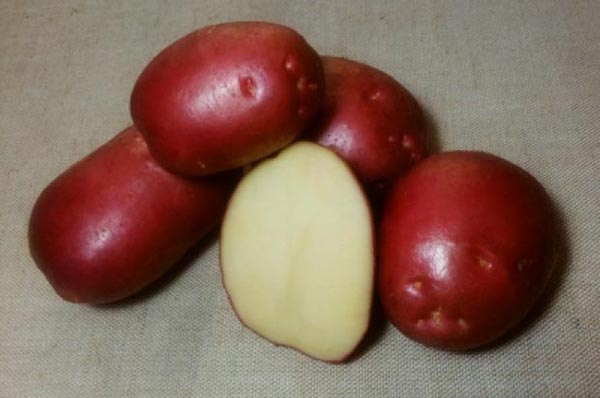
The pulp tastes good to excellent. Does not boil over during cooking. Suitable for processing into crispy potatoes, i.e. for making chips and fries.
Characteristics of the Rocco variety:
- ripening period - mid-season (90-110 days);
- tubers are oval;
- the structure of the peel is smooth;
- peel color - red;
- pulp color - cream;
- the depth of the eyes is shallow;
- starch content - 12.9-14.5%;
- yield per hundred square meters - 136-261 kg (maximum up to 275 kg); 0
- the number of tubers per bush - 8-12;
- the average weight of 1 tuber is 75-119 g;
- marketability - 84-96%;
- keeping quality - 89%.
The appearance of the plant is of medium height, intermediate type, semi-erect. The leaf is medium sized, open, green. The waviness of the edge is medium. The flowers are large, reddish-purple.
Recommended for planting regions: Volgo-Vyatka, Srednevolzhsky, West Siberian.
Patent holder and / or originator of the variety: Niederosterreicische Saatbaugenossenschaft (Austria).
Ryabinushka
Medium early variety, for table use, high yield, good taste.
The variety easily adapts to agro-climatic conditions, has a high heat and drought resistance. It responds well to watering and timely application of fertilizers. It is recommended to germinate the tubers before planting.
It is highly resistant to damage by the Colorado potato beetle. The variety is resistant to mechanical damage. Resistant to the causative agent of potato cancer and nematodes. Moderately susceptible to tops and moderately resistant to tubers to the causative agent of late blight.
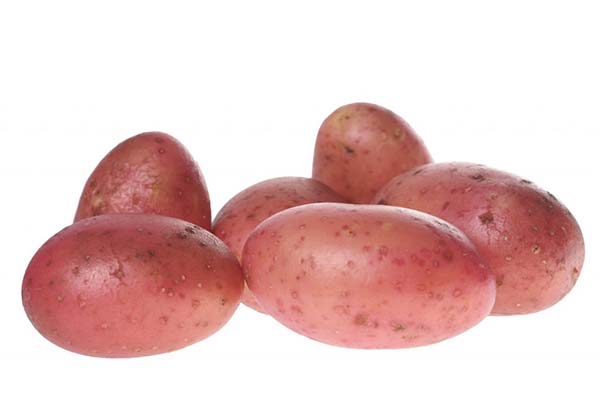
The taste is good. Culinary type B. The boil-off is weak. The pulp does not darken during cooking.
Characteristics of the Ryabinushka variety:
- ripening period - medium early (80-90 days);
- tubers are oval;
- the structure of the peel is smooth;
- peel color - red;
- pulp color - white (cream);
- the depth of the eyes is shallow;
- starch content - 11.9-15%;
- yield per hundred square meters - 220-234 kg (maximum up to 396 kg);
- the number of tubers per bush - 15-18;
- the average weight of 1 tuber is 91-133 g;
- marketability - 86-96%;
- keeping quality - 90%.
The appearance of the plant is medium or tall, semi-erect. Medium or large leaves are dark green, and the inflorescences are violet-blue. Berry formation is absent.
Recommended for planting regions: North, North-West, Central, Volgo-Vyatka, Central Black Earth region, North Caucasian, Middle Volga, West Siberian, Far East.
Patent holder and / or originator of the variety: LLC Vsevolozhskaya breeding station (Russia).
Sante (Santa)
Medium early variety, versatile, high yield, good taste.
In the process of cultivation, it needs to create wide row spacings, as well as timely watering before the flowering period, since at a temperature of 29 degrees and above, the growth of shoots and tubers slows down.
Important! Planting Santa should be carried out at a soil temperature of at least 8 degrees.
It stands out for its high yield. Suitable for mechanical collection and processing, besides, it is perfectly stored and is not prone to germination.
Resistant to cancer, potato nematode, late blight, viruses, moderately resistant to common scab, susceptible to rhizoctonia.
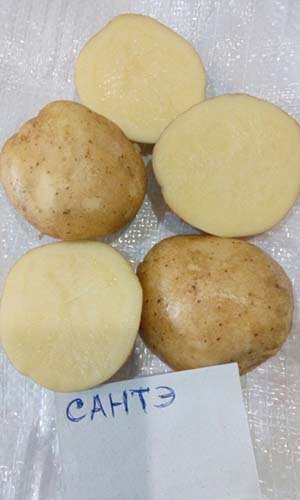
The taste of the Santa potatoes is good. The pulp does not darken during the cooking process. Suitable for frying, cooking French fries and chips. Not suitable for mashed potatoes and cooking.
Characteristics of the Sante variety:
- ripening period - medium early (80-90 days);
- tubers are oval;
- the structure of the peel is smooth;
- peel color - yellow;
- pulp color - light yellow;
- the depth of the eyes is shallow;
- starch content - 10-14%;
- yield per one hundred square meters - up to 570 kg;
- the number of tubers per bush - up to 20;
- the average weight of 1 tuber is 90-120 g;
- marketability is good
- keeping quality - 92% (good).
Santa is distinguished by erect tall shoots and white inflorescences.
Recommended for planting regions: North, North-West, Central, Volgo-Vyatka, Nizhnevolzhsky, Uralsky, West Siberian, Far East.
Patent holder and / or originator of the variety: Agrico U.A. (Holland).
Svitanok Kiev
Medium early variety, versatile, high yield, excellent taste.
It adapts to any type of soil, resistant to the Colorado potato beetle.
Resistant to potato cancer and rhizoctonia. Medium resistant to mosaic viruses, common scab, black leg. Moderately susceptible to late blight. Susceptible to nematode and leaf roll virus.
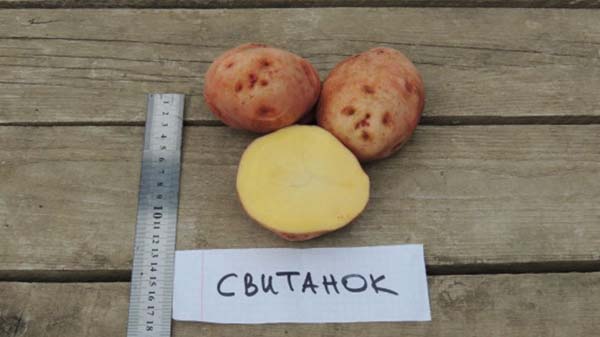
The taste is excellent. It boils well, suitable for mashed potatoes.
Characteristics of the Svitanok Kievsky variety:
- ripening period - medium early (80-90 days);
- the shape of the tubers is round;
- the structure of the peel is smooth;
- peel color - pink;
- pulp color - cream;
- the depth of the eyes is shallow;
- starch content - 16-19%;
- yield per hundred square meters - up to 460 kg;
- number of tubers per bush - 8-12
- the average weight of 1 tuber is 100-130 g;
- marketability is good;
- keeping quality - 95% (good).
The appearance of the plant is low, erect. Inflorescences are light red-violet.
Recommended for planting regions: North-West, Central, Middle Volga, Ural, West Siberian, Far East.
Patent holder and / or originator of the variety: Institute of Potato Growing UAAS (Ukraine).
Scarb
Mid-season variety, for table use, high yield, normal taste.
Suitable for growing on all types of soil, responds well to applied fertilizers. Medium drought tolerant, sensitive to waterlogging in the early stages of growth. To obtain fast and uniform shoots before planting, it needs germination or heating of tubers. In addition, planting should only be carried out with whole tubers. Moreover, planting should be deep, followed by high hilling after germination.
Resistant to wrinkled, striped mosaics. Resistant to the causative agent of potato cancer and nematodes. Susceptible to late blight pathogen in tops and tubers.
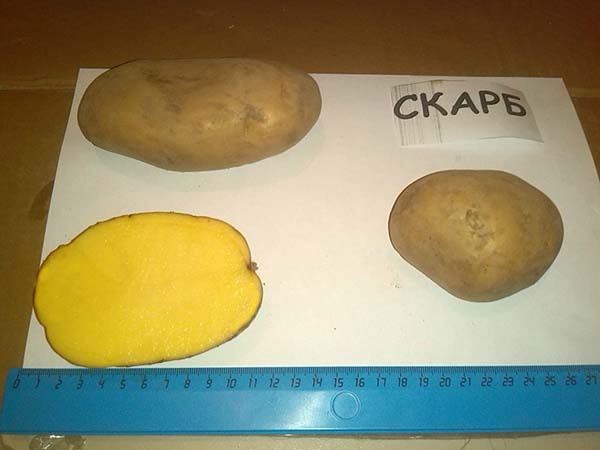
The taste is satisfactory and good. Culinary type B. The pulp does not boil over during cooking (boil-through is weak) and does not darken. The variety is recommended for making salads, chips, potato pancakes (pancakes), French fries.
Characteristics of the Scarb variety:
- ripening period - mid-season (90-110 days);
- tubers are oval;
- the structure of the peel is smooth;
- peel color - yellow;
- the color of the pulp is yellow;
- the depth of the eyes is very shallow;
- starch content - 12-17%;
- yield per hundred square meters - 253-411 kg (maximum up to 508 kg);
- the number of tubers per bush - 10-14;
- the average weight of 1 tuber is 94-138 g;
- marketability - 84-99%;
- keeping quality - 88-99%.
The variety is distinguished by medium-sized semi-upright bushes of an intermediate type. The leaves are small and open, dark green in color. No or very slight waviness in the edge. Inflorescences are white. Berry formation is rare.
Recommended for planting regions: North-West, Central, Volgo-Vyatka, Ural.
Patent holder and / or originator of the variety: RUE "Scientific and Production Center of the National Academy of Sciences of Belarus for Potato and Fruit Growing" (Belarus).
Tuleyevsky
Mid-season variety, for table use, high-yielding, good taste.
Interesting! The variety is named after the governor of the Kemerovo region, Aman Gumirovich Tuleyev.
The variety reacts negatively to chemical fertilizers and watering, so it is recommended to use only humus when growing. With a lack of boron in the soil, voids appear inside the tubers. Three-fold hilling is necessary (after emergence, during flowering, after declension of tops in the aisles).
Resistant to the causative agent of potato cancer, susceptible to nematode. Moderately resistant to tops and moderately susceptible to tubers to the causative agent of late blight. The crop easily tolerates transportation, without loss of marketability (resistant to mechanical damage).
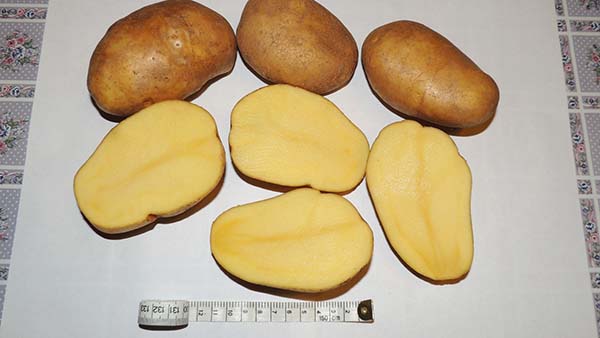
Taste good or great. Culinary type VS. Cooking is moderate, the flesh does not darken. Suitable for all kinds of dishes.
Characteristics of the Tuleyevsky variety:
- ripening period - mid-season (90-110 days), according to other sources, mid-early (80-90 days;);
- tubers are oval-elongated;
- the structure of the peel is reticulated (rough);
- peel color - yellow;
- the color of the pulp is yellow;
- the depth of the eyes is very shallow;
- starch content - 13.7-16.8%;
- yield per one hundred square meters - 180-424 kg (maximum up to 458 kg);
- the number of tubers per bush - 8-10;
- the average weight of 1 tuber is 122-270 g;
- marketability - 88-99%;
- keeping quality - 90%.
The appearance of the plant is a bush of medium height, intermediate type, semi-erect. Medium leaf, intermediate to open, dark green. Inflorescences are white.Flowering is not abundant, while the inflorescences have a purple tone with a yellow center. Berry formation is rare.
Recommended for planting regions: Volgo-Vyatka, West Siberian, East Siberian, Far East.
Patent holder and / or originator of the variety: FGBNU “All-Russian Research Institute of Potato Farming named after A.G. Lorkha (Russia).
Luck
Early variety, table variety, high-yielding, normal (satisfactory) taste.
Productivity is stable in a favorable climate for crops. The choice of soil does not matter. It tolerates well both waterlogging and lack of moisture in the soil.
Moderately susceptible to late blight in tops and moderately resistant to tubers. Not damaged during transportation (resistant to mechanical damage).
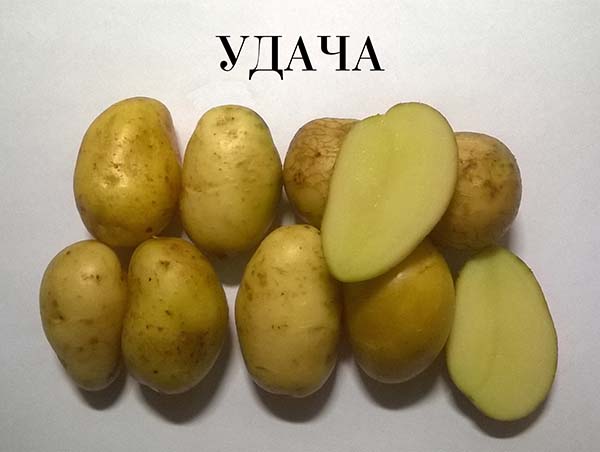
Fair to good taste. Culinary type B. The digestibility is weak, the pulp darkens slightly. Suitable for making soups and salads, as well as frying, making fries and chips.
Characteristics of the variety Luck:
- ripening period - early (70-80 days);
- the shape of the tubers is round-oval;
- the structure of the peel is smooth;
- peel color - light beige (cream);
- the color of the pulp is white;
- the depth of the eyes is shallow;
- starch content - 12-15%;
- yield per hundred square meters - 300-500 kg;
- the number of tubers per bush - up to 10-14;
- the average weight of 1 tuber is 100-150 g;
- marketability - 96%;
- keeping quality is good;
The appearance of the plant is medium, semi-spreading. Leaves with large lobes, dark green. Inflorescences are snow-white. Berry formation is rare.
Recommended regions for planting: North-West, Central, Volgo-Vyatka, Central Black Earth Region, North Caucasus, Middle Volga, Ural, Far East.
Patent holder and / or originator of the variety: FGBNU “All-Russian Research Institute of Potato Farming named after A.G. Lorkha (Russia).
Uladar
An early variety, for table use, high yield, good taste.
Not picky about the composition of the soil, it can be grown on light and medium-sized soils. Reacts well to mineral fertilizing.
Differs in early tuberization in the first half of the growing season.
Resistant to the causative agent of potato cancer, nematode, wrinkled and banded mosaic. Moderately resistant on leaves and tubers to the causative agent of late blight, leaf rolling. Moderately susceptible to common scab and rhizoctonia. Tubers are moderately resistant to mechanical damage.
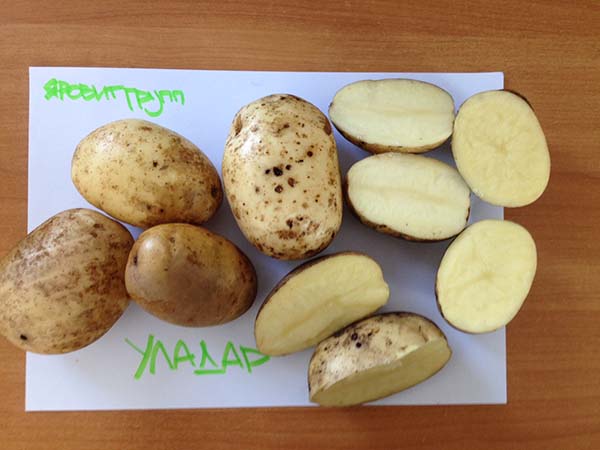
Good or excellent taste. Culinary type B. The boil-off is weak. Uladar is great for frying and cooking chips.
Characteristics of the Uladar variety:
- ripening period - early (70-80 days);
- the shape of tubers - from oval to oval-rounded (elongated-oval);
- the structure of the peel is smooth;
- peel color - yellow;
- pulp color - light yellow (creamy yellow);
- the depth of the eyes is very shallow;
- starch content - 13.8-17.5%;
- yield per hundred square meters - 127-353 kg (maximum up to 424 kg);
- the number of tubers per bush - 6-11;
- the average weight of 1 tuber is 91-140 g;
- marketability - 90-95%;
- keeping quality - 94%.
The variety is characterized by bushes of medium size, intermediate type, semi-erect. Forms thin stems with medium-sized leaves, slight waviness of the edge. Inflorescences are red-purple.
Recommended planting regions: Northwest, Central.
Patent holder and / or originator of the variety: RUE "Scientific and Production Center of the National Academy of Sciences of Belarus for Potato and Fruit Growing" (Belarus).
The best potato varieties by timingmaturation
Potato varieties are also subdivided into types depending on the ripening period of the tubers. In this case, the number of days that must pass from the moment the first sprouts appear until the tubers are fully ripe is taken into account.
Note! Information about the ripening time of each variety is given in its description (characteristic), here, just for convenience, the names of the varieties are grouped by their ripening dates (alphabetically).
Earliest
By the way! If you are interested in the mostearly potato varieties, then for your convenience all information on such varieties is grouped in this article.
Of those already described in the review, very early and early varieties (60-80 days) are:
- Bellarosa;
- Vineta;
- Zhukovsky early;
- Impala;
- Kamensky;
- Colomba;
- Queen Anne;
- Labella;
- Lyubava;
- Meteor;
- Rosara;
- Luck;
- Uladar.
Mid-season
Medium early varieties (80-90 days):
- Adretta;
- Breeze;
- Gala;
- Zecura;
- Nevsky;
- Red Scarlett;
- Riviera;
- Rodrigue;
- Ryabinushka;
- Sante;
- Svitanok Kiev.
Mid-season varieties (90-110 days):
- Aurora;
- Vector;
- Blueness (according to some sources, medium late);
- Kolobok;
- Lugovskoy;
- Roco;
- Scarb;
- Tuleyevsky (according to some sources mid-early).
Late
The best mid-late and late varieties (110-120 days):
- Zhuravinka;
- Kiwi;
- Lasunak;
- Picasso.
And also this:
- Lorkh;
- Manifesto;
- Son;
- Pace;
- Purple.
The best potato varieties for different regions
When choosing a variety, one should pay attention not only to the yield and taste of tubers, but also to the combination of all indicators, which will allow achieving crop stability in the conditions of your region, since not every type of crop is able to show good results in different climatic conditions.
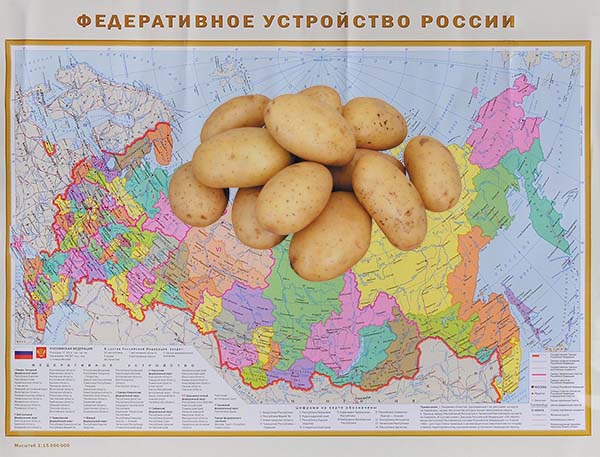
Note! Information on the recommended planting regions for each variety is given in its description (at the end), here, just for convenience, the names of varieties (in alphabetical order) are listed, suitable for growing in specific regions.
For the Middle Lane (Moscow region)
In the Central region (Middle lane, Moscow region), it is recommended to plant the following potato varieties (from those presented in the review):
- Aurora;
- Breeze;
- Vector;
- Vineta;
- Gala;
- Blue;
- Zhukovsky early;
- Zhuravinka;
- Impala;
- Kiwi;
- Kolobok;
- Colomba;
- Queen Anne;
- Labella;
- Lasunak;
- Lugovskaya;
- Meteor;
- Nevsky;
- Picasso;
- Red Scarlet;
- Riviera;
- Rodrigue;
- Ryabinushka;
- Sante;
- Svitanok Kiev;
- Scarb;
- Luck;
- Uladar.
For the North-West (Leningrad region)
In the Northwest region (Leningrad region), it is recommended to plant the following potato varieties (from those described in the review):
- Aurora;
- Bellarosa;
- Breeze;
- Gala;
- Zhukovsky early;
- Zhuravinka;
- Impala;
- Colomba;
- Queen Anne;
- Lasunak;
- Lugovskaya;
- Nevsky;
- Red Scarlet;
- Rosara;
- Ryabinushka;
- Sante;
- Svitanok Kiev;
- Scarb;
- Luck;
- Uladar.
For the Urals
Important! You can read a detailed review of the best potato varieties for growing in the Urals. in this material.
And from those previously voiced in the review:
- Bellarosa;
- Vineta;
- Zhukovsky early;
- Kamensky;
- Labella;
- Lugovskoy;
- Lyubava;
- Meteor;
- Nevsky;
- Rosara;
- Sante;
- Svitanok Kiev;
- Scarb;
- Luck.
For Siberia (Western and Eastern)
Note! A separate overview of varieties suitable for planting in Western and Eastern Siberia, you will find here.
Of those previously named in the review, these are:
- Aurora (Eastern);
- Adretta (Western);
- Zhukovsky early (Western);
- Zekura (Western);
- Kamenskaya (Western);
- Queen Anne (East and West);
- Lugovskaya (East and West);
- Lyubava (East and West);
- Meteor (Western);
- Red Scarlet (West);
- Rosara (East and West);
- Roco (Western);
- Ryabinushka (Western);
- Sante (Western);
- Svitanok Kiev (Western);
- Tuleyevsky (East and West).
The best varieties of potatoes of domestic and foreign selection
Of course, Russia has enough of its own varieties, but many Dutch and German varieties have gained particular popularity. It is hard not to note that for many years many gardeners have been successfully cultivating the famous Ukrainian and, of course, Belarusian varieties of potatoes.
Note! Information about the country of origin of the variety is given in its description (at the end), here, just for convenience, the names of the varieties are grouped by origin (alphabetically), as well as the names of other less popular varieties.
Russian
Interesting! Russia is the third largest potato producer in the world (31.1 million tons). The first - from China (99.1 million tons), the second - from India (43.8 million tons).
Data from the UN Food Organization (FAO) for 2016.
According to the FCSIn 2017, Russia bought 25.8 thousand tons of seed potatoes for $ 14.1 million abroad. The main suppliers were the Netherlands (33% in value terms) and Germany (27%). In addition to European countries, Russia buys seed potatoes from Belarus (4.5% of supplies this year) and China (3.1%).
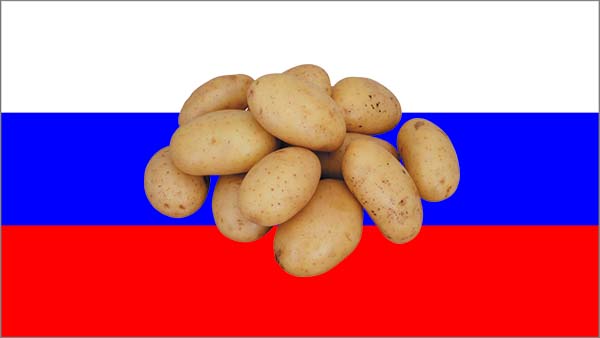
Of the varieties already described in the review, the best representatives of Russian selection are:
- Aurora;
- Blue;
- Zhukovsky early;
- Kamensky;
- Kolobok;
- Lyubava;
- Meteor;
- Nevsky;
- Ryabinushka;
- Tuleyevsky;
- Luck;
Of course, there are many other less popular, but quite good Russian varieties, the most famous of which are:
- Alyona;
- Vyatka;
- Elizabeth;
- Irbit;
- Lorkh;
- Purple.
Ukrainian
Interesting! Although there are not so many Ukrainian varieties, especially well-known in Russia, Ukraine ranks 4th in terms of potato production in the world (21.8 million tons).
Data from the UN Food Organization (FAO) for 2016.
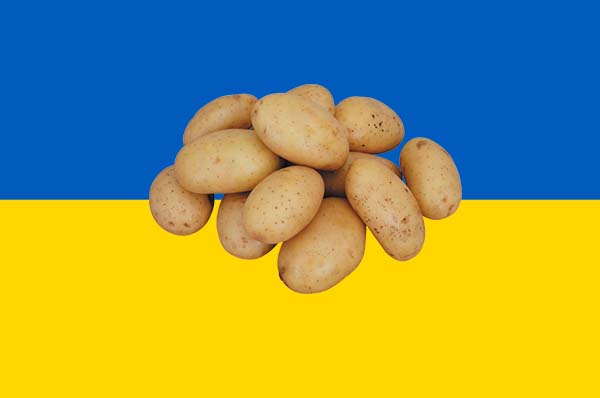
The best varieties of Ukrainian breeding presented in the review are:
- Lugovskoy;
- Svitanok Kiev.
And also other varieties:
- Gourmet;
- Dnipryanka;
- Fun;
- Glow;
- Povin;
- Serpanok;
- Slav;
- Teterev;
- Chervona Ruta.
Belarusian
If in Western Europe Holland can be called the second homeland of potatoes, then in Eastern Europe it is certainly Belarus.
Interesting! The real homeland of potatoes is South America (Peru, Bolivia, Chile).
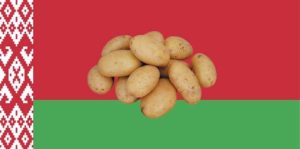
The best Belarusian varieties described in the review are:
- Breeze;
- Zhuravinka;
- Lasunka;
- Scarb;
- Uladar.
And also varieties such as:
- Axamite;
- Surplus;
- Crane;
- Lileya Belarusian;
- Manifesto;
- Pace;
- Yanka.
Dutch
Interesting! Despite the fact that Dutch varieties are popular all over the world, the Netherlands occupies only 10th place in potato production (6.5 million tons), leaving Germany far behind (10.7 million tons).
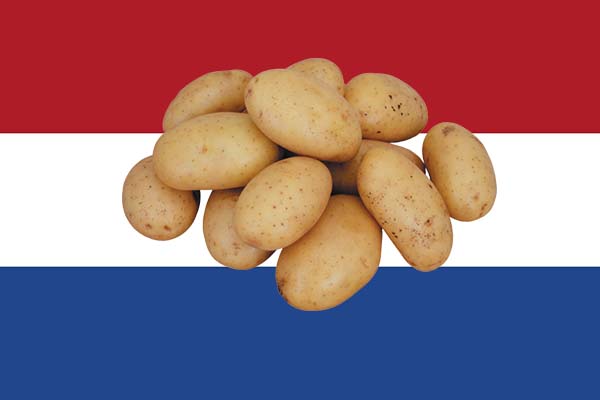
So, the best varieties of Dutch breeding potatoes presented in the review are:
- Impala;
- Colomba (Colombo);
- Labella;
- Picasso;
- Red Scarlet;
- Riviera;
- Sante (Santa);
And:
- Vega;
- Condor;
- Latona;
- Lady Claire;
- Ukama.
German
By the way! German varieties, along with Dutch ones, are considered one of the best in Europe and the world, and Germany itself ranks 6th in the world in potato production (10.7 million tons).
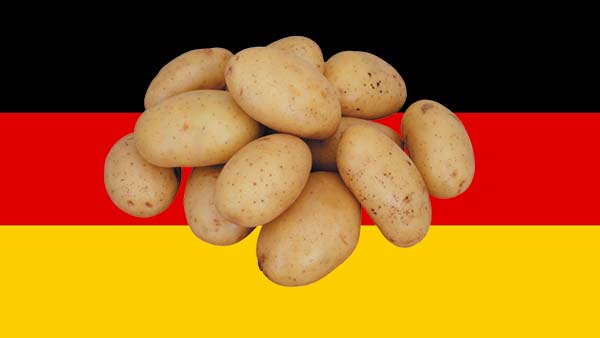
The best varieties of German breeding potatoes presented in the review are:
- Adretta;
- Bellarosa;
- Vineta;
- Gala;
- Zecura;
- Queen Anne;
- Rodrigue;
- Rosara.
And also slightly less well-known varieties:
- Arosa;
- Jelly;
- Karatop;
- Laura.
By the way! The review also includes one Austrian variety - Roco (Rocco).
Of course, choosing a variety for yourself and your needs (taste preferences and goals), your site (soil fertility) and the climatic conditions of the region is quite difficult, but, as you understand, there is a sufficient variety of varieties, among which there will certainly be those that can satisfy any your needs and capabilities.
Important! You should not "get hung up" on one favorite variety, it is better to grow several on the site at once, because the yield of the variety can fluctuate from season to season. Moreover, each variety, as a rule, is especially good for certain purposes: some are for making mashed potatoes, others for frying, third varieties are suitable for early digging for the sake of young potatoes, the fourth are for long winter storage and have a fairly universal application.


Hello! Tell me where you can buy potato seeds that I liked, I live in the Lipetsk region.
Good day!
In specialized stores, for example, I found that you have a garden center in Fazenda in your city, which has as many as 4 points:
Lipetsk, st. 60 years of the USSR, d. 21. >
+7 (4742) 405-436
Lipetsk, per. Rudny, 17.
+7 (4742) 555-117,
Lipetsk, st. Kochetkova, 2.
+7 (4742) 566-400
Lipetsk, st. Zoya Kosmodemyanskaya, 8. (T.Ts. "Kvartal")
As a last resort, find a bona fide seller on Avito.